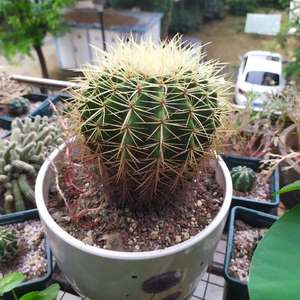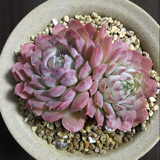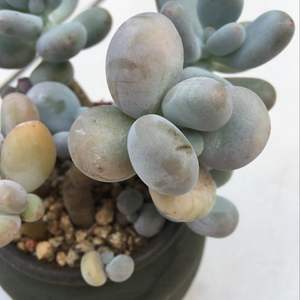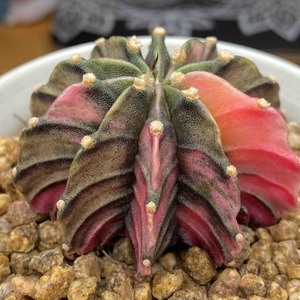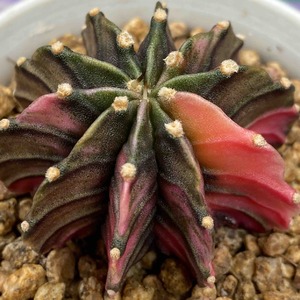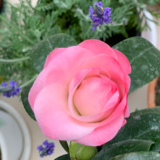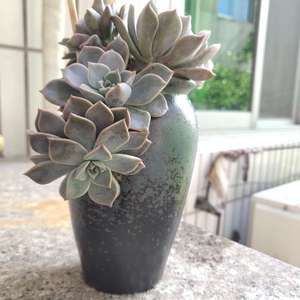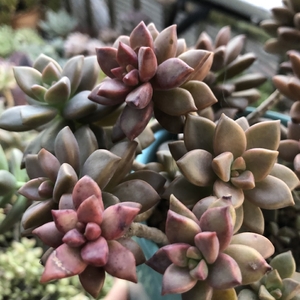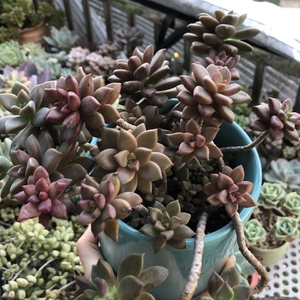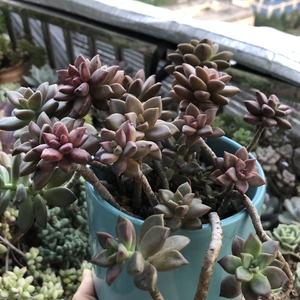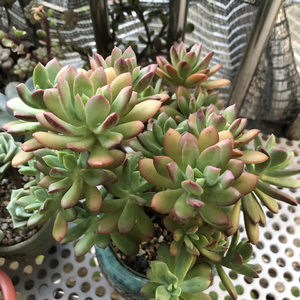文章
Miss Chen
2020年09月13日

方鳞绿塔在养殖时需用腐叶土、泥炭土、河沙混合做基质,可使其更好的生长,还要给其充足的光照,不过夏季时需给其3~4小时光照,生长期间可每隔7~10天浇一次水,每隔15~20天施一次淡薄磷肥,平时常用分株法繁殖方鳞绿塔。
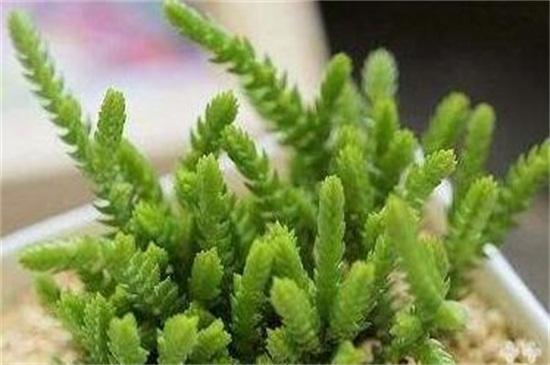
1、盆土需求
方鳞绿塔对土壤要求不是很高,它需要生长在疏松、肥沃、透气排水性良好的土壤中,一般可用营养土养殖方鳞绿塔,不过最好还是要腐叶土、泥炭土、河沙按照2:2:1的比例混合做基质。
2、光照需求
方鳞绿塔在养殖过程中,如果光照不足很容易使其徒长,在方鳞绿塔的养殖方法和注意事项里,平时最好将方鳞绿塔摆放在阳光处给其充足的光照,夏季时做好遮阴防晒,给其3~4小时散射光照就可以了。
3、水肥管理
当方鳞绿塔生长旺盛时,可每隔7~10天浇一次水,使土壤保持微湿状态就可以了,还要每隔15~20天施一次淡薄磷肥,使其生长的更好,当阴雨天时不仅需要停止浇水,还要做好排水工作,也不要将水分和肥料洒在叶片上,会使其逐渐腐烂。

4、分株繁殖
一般方鳞绿塔每次给其进行翻盆换土时,可从基部摘取健壮的分株,将母株伤口处涂抹草木灰,重新种植到土壤里,分株伤口处需喷洒药剂杀菌,放在阴凉光照处1~2天时间,然后种植到盆土里就可以了。
5、注意事项
方鳞绿塔适合生长在15~26℃的温度下,它是比较耐寒的植物,但不能在温度0℃以下生长,很容易冻伤植株,使其无法在盆土中正常生长,所以冬季时最好将其摆放在室内养护,温度控制在0~5℃最佳。

1、盆土需求
方鳞绿塔对土壤要求不是很高,它需要生长在疏松、肥沃、透气排水性良好的土壤中,一般可用营养土养殖方鳞绿塔,不过最好还是要腐叶土、泥炭土、河沙按照2:2:1的比例混合做基质。
2、光照需求
方鳞绿塔在养殖过程中,如果光照不足很容易使其徒长,在方鳞绿塔的养殖方法和注意事项里,平时最好将方鳞绿塔摆放在阳光处给其充足的光照,夏季时做好遮阴防晒,给其3~4小时散射光照就可以了。
3、水肥管理
当方鳞绿塔生长旺盛时,可每隔7~10天浇一次水,使土壤保持微湿状态就可以了,还要每隔15~20天施一次淡薄磷肥,使其生长的更好,当阴雨天时不仅需要停止浇水,还要做好排水工作,也不要将水分和肥料洒在叶片上,会使其逐渐腐烂。

4、分株繁殖
一般方鳞绿塔每次给其进行翻盆换土时,可从基部摘取健壮的分株,将母株伤口处涂抹草木灰,重新种植到土壤里,分株伤口处需喷洒药剂杀菌,放在阴凉光照处1~2天时间,然后种植到盆土里就可以了。
5、注意事项
方鳞绿塔适合生长在15~26℃的温度下,它是比较耐寒的植物,但不能在温度0℃以下生长,很容易冻伤植株,使其无法在盆土中正常生长,所以冬季时最好将其摆放在室内养护,温度控制在0~5℃最佳。
0
0
文章
Miss Chen
2020年08月22日

熊童子多肉看起来就像迷你型号毛茸茸的小熊爪子一样,养的好的熊童子会有出锦的可能,出锦的熊童子的身价最起码长了10倍,那么熊童子出锦后怎么养呢?养殖的时候注意用浅盆,土壤也要换成松散一些的,不要挪动,少浇水,懒养即可。

一、熊童子出锦后养殖方法
1、换浅盆
其实熊童子出锦前后的养殖注意事项是没有变的,但是植株只是更好看一些了。换上一个稍微浅一点的花盆,这样是为了能够更加方便的观察到植株的根部的生长状态,让花友更加清楚养殖之中的问题。要是出现浇水过多,腐坏根部的时候也会很快可以看出。
2、土壤疏松
很多花友都不知道熊童子出锦后怎么养,其实最重要的就是要换土壤了。没有出锦的熊童子养殖非常简便,一般的土壤都可以,但是一旦出锦就要将植株的土壤换成更加疏松的。用河沙、泥炭土和煤渣混合,以4:4:2的比例来调配,千万不要用腐叶土,会让熊童子有感染细菌的可能的。
3、减少浇水
熊童子浇水本身就不多,但是除了锦的熊童子浇水则要更加的少,只有少量浇水,才会让“熊掌”上得斑纹越来越明显,越来越多,这样熊童子的身价就会越来越高了。基本上保持20天浇水一次,夏天喷洒一些水雾,冬天保持土壤稍稍的干燥。
4、少施肥
熊童子出锦之后虽然身价变高,但是养殖它却要简单很多,不仅是浇水少量,就连施肥也是能省则省。生长期的时候1~2个月只需要施肥一次即可。而且不能施加浓肥,淡肥就行了。除此之外,基本上不要移动盆栽,就会养的很好了。

二、熊童子出锦后的好处
1、更加漂亮
很多花友在养熊童子的时候都会想要让熊童子出锦,实际上出锦就像是得了黄化病一样,“熊爪”上面会生出一点不一样的斑纹,有的是黄色的,有的是白色的,但是这却并不是生病,只是变得更加漂亮了而已。出了锦的熊童子又被称为彩熊,是很多颜控小妹妹的心中最爱。
2、更好养
熊童子多肉养起来已将很方便了,但是出了锦的熊童子养殖起来就更加简单了,浇水也只要20天一次,干旱也没有关系,施肥更是1~2个月才加一次,光照也不忌讳,甩手养都可以养的很好。出了锦的熊童子简直是懒人养花最好的选择了。
3、价格变贵
熊童子出了锦之后就相当于是一种变种植物了,这是非常难得的。一般的熊童子想要出锦都是非常难得的,一般都是用机遇来形容这种概率,是可遇不可求的。但是一旦出锦成功之后,就会身价倍增。由一种普通多肉直接升级成为高档货。
一般来讲一小盆熊童子在花店里面的卖家只要15~30元左右,要是你买回家之后细心养护,熊童子出锦之后,一盆的价格甚至会达到十倍以上,品相好的卖上个300原都不是难事。要是用彩熊叶插繁殖出好几盆的花,分别卖出去也是很不错的生财之道了。
结语:通过上文的的介绍,相信大家已经明白熊童子出锦之后的养殖方法了。其实只要换了盆土之后,保持懒养,它还就会变得更加漂亮了哦。

一、熊童子出锦后养殖方法
1、换浅盆
其实熊童子出锦前后的养殖注意事项是没有变的,但是植株只是更好看一些了。换上一个稍微浅一点的花盆,这样是为了能够更加方便的观察到植株的根部的生长状态,让花友更加清楚养殖之中的问题。要是出现浇水过多,腐坏根部的时候也会很快可以看出。
2、土壤疏松
很多花友都不知道熊童子出锦后怎么养,其实最重要的就是要换土壤了。没有出锦的熊童子养殖非常简便,一般的土壤都可以,但是一旦出锦就要将植株的土壤换成更加疏松的。用河沙、泥炭土和煤渣混合,以4:4:2的比例来调配,千万不要用腐叶土,会让熊童子有感染细菌的可能的。
3、减少浇水
熊童子浇水本身就不多,但是除了锦的熊童子浇水则要更加的少,只有少量浇水,才会让“熊掌”上得斑纹越来越明显,越来越多,这样熊童子的身价就会越来越高了。基本上保持20天浇水一次,夏天喷洒一些水雾,冬天保持土壤稍稍的干燥。
4、少施肥
熊童子出锦之后虽然身价变高,但是养殖它却要简单很多,不仅是浇水少量,就连施肥也是能省则省。生长期的时候1~2个月只需要施肥一次即可。而且不能施加浓肥,淡肥就行了。除此之外,基本上不要移动盆栽,就会养的很好了。

二、熊童子出锦后的好处
1、更加漂亮
很多花友在养熊童子的时候都会想要让熊童子出锦,实际上出锦就像是得了黄化病一样,“熊爪”上面会生出一点不一样的斑纹,有的是黄色的,有的是白色的,但是这却并不是生病,只是变得更加漂亮了而已。出了锦的熊童子又被称为彩熊,是很多颜控小妹妹的心中最爱。
2、更好养
熊童子多肉养起来已将很方便了,但是出了锦的熊童子养殖起来就更加简单了,浇水也只要20天一次,干旱也没有关系,施肥更是1~2个月才加一次,光照也不忌讳,甩手养都可以养的很好。出了锦的熊童子简直是懒人养花最好的选择了。
3、价格变贵
熊童子出了锦之后就相当于是一种变种植物了,这是非常难得的。一般的熊童子想要出锦都是非常难得的,一般都是用机遇来形容这种概率,是可遇不可求的。但是一旦出锦成功之后,就会身价倍增。由一种普通多肉直接升级成为高档货。
一般来讲一小盆熊童子在花店里面的卖家只要15~30元左右,要是你买回家之后细心养护,熊童子出锦之后,一盆的价格甚至会达到十倍以上,品相好的卖上个300原都不是难事。要是用彩熊叶插繁殖出好几盆的花,分别卖出去也是很不错的生财之道了。
结语:通过上文的的介绍,相信大家已经明白熊童子出锦之后的养殖方法了。其实只要换了盆土之后,保持懒养,它还就会变得更加漂亮了哦。
0
0
文章
ritau
2020年06月29日

The pomegranate (Punica granatum) is a fruit-bearing deciduous shrub in the family Lythraceae, subfamily Punicoideae, that grows between 5 and 10 m (16 and 33 ft) tall.
The pomegranate originated in the region extending from Iran to northern India, and has been cultivated since ancient times throughout the Mediterranean region. It was introduced into Spanish America in the late 16th century and into California by Spanish settlers in 1769.
The fruit is typically in season in the Northern Hemisphere from September to February, and in the Southern Hemisphere from March to May. As intact sarcotestas or juice, pomegranates are used in baking, cooking, juice blends, meal garnishes, smoothies, and alcoholic beverages, such as cocktails and wine.
Today, it is widely cultivated throughout the Middle East and Caucasus region, north and tropical Africa, the Indian subcontinent, Central Asia, the drier parts of southeast Asia, and parts of the Mediterranean Basin. It is also cultivated in parts of Arizona and the San Joaquin Valley in California. In the 20th and 21st centuries, it has become more common in the shops and markets of Europe and the Western Hemisphere.
The name pomegranate derives from medieval Latin pōmum "apple" and grānātum "seeded". Possibly stemming from the old French word for the fruit, pomme-grenade, the pomegranate was known in early English as "apple of Grenada"—a term which today survives only in heraldic blazons. This is a folk etymology, confusing the Latin granatus with the name of the Spanish city of Granada, which derives from Arabic.
Garnet derives from Old French grenat by metathesis, from Medieval Latin granatum as used in a different meaning "of a dark red color". This derivation may have originated from pomum granatum, describing the color of pomegranate pulp, or from granum, referring to "red dye, cochineal".
The French term for pomegranate, grenade, has given its name to the military grenade.

*Nutrition
A 100 g (3.5 oz) serving of pomegranate sarcotesta provides 12% of the Daily Value (DV) for vitamin C, 16% DV for vitamin K and 10% DV for folate (table).
Pomegranate seeds are a rich source of dietary fiber (20% DV) which is entirely contained in the edible seeds. People who choose to discard the seeds forfeit nutritional benefits conveyed by the seed fiber and micronutrients.
*Symbolism
-Ancient Egypt
Ancient Egyptians regarded the pomegranate as a symbol of prosperity and ambition. It was referred to by the Semitic names of jnhm or nhm.According to the Ebers Papyrus, one of the oldest medical writings from around 1500 BC, Egyptians used the pomegranate for treatment of tapeworm and other infections.
-Ancient and Modern Greece
The Greeks were familiar with the fruit far before it was introduced to Rome via Carthage, and it figures in multiple myths and artworks. In Ancient Greek mythology, the pomegranate was known as the "fruit of the dead", and believed to have sprung from the blood of Adonis.
The myth of Persephone, the goddess of the underworld, prominently features her consumption of pomegranate seeds, requiring her to spend a certain number of months in the underworld every year. The number of seeds and therefore months varies. During the months, while Persephone sits on the throne of the underworld beside her husband Hades, her mother Demeter mourned and no longer gave fertility to the earth. This was an ancient Greek explanation for the seasons.
According to Carl A. P. Ruck and Danny Staples, the chambered pomegranate is also a surrogate for the poppy's narcotic capsule, with its comparable shape and chambered interior. On a Mycenaean seal illustrated in Joseph Campbell's Occidental Mythology (1964), figure 19, the seated Goddess of the double-headed axe (the labrys) offers three poppy pods in her right hand and supports her breast with her left. She embodies both aspects of the dual goddess, life-giving and death-dealing at once.
The Titan Orion was represented as "marrying" Side, a name that in Boeotia means "pomegranate", thus consecrating the primal hunter to the Goddess.
In the 5th century BC, Polycleitus took ivory and gold to sculpt the seated Argive Hera in her temple. She held a scepter in one hand and offered a pomegranate, like a "royal orb", in the other. "About the pomegranate I must say nothing," whispered the traveller Pausanias in the 2nd century, "for its story is somewhat of a holy mystery."The pomegranate has a calyx shaped like a crown. In Jewish tradition, it has been seen as the original "design" for the proper crown.
A pomegranate is displayed on coins from Side. The ancient Greek city of Side was in Pamphylia, a former region on the southern Mediterranean coast of Asia Minor (modern-day Antalya province, Turkey).

Within the Heraion at the mouth of the Sele, near Paestum, Magna Graecia, is a chapel devoted to the Madonna del Granato, "Our Lady of the Pomegranate", "who by virtue of her epithet and the attribute of a pomegranate must be the Christian successor of the ancient Greek goddess Hera", observes the excavator of the Heraion of Samos, Helmut Kyrieleis.
In modern times, the pomegranate still holds strong symbolic meanings for the Greeks. When one buys a new home, it is conventional for a house guest to bring as a first gift a pomegranate, which is placed under/near the ikonostasi (home altar) of the house, as a symbol of abundance, fertility, and good luck. When Greeks commemorate their dead, they make kollyva as offerings, which consist of boiled wheat, mixed with sugar and decorated with pomegranate. Pomegranate decorations for the home are very common in Greece and sold in most home goods stores.
-China
The pomegranate is regarded as a symbol of fertility in China.
Introduced to China during the Han Dynasty (206 BC–220 AD), the pomegranate (Chinese: 石榴; pinyin: shíliu) in olden times was considered an emblem of fertility and numerous progeny. This symbolism is a pun on the Chinese character 子 (zǐ) which, as well as meaning seed, also means "offspring" thus a fruit containing so many seeds is a sign of fecundity. Pictures of the ripe fruit with the seeds bursting forth were often hung in homes to bestow fertility and bless the dwelling with numerous offspring, an important facet of traditional Chinese culture.
-In European Christian motifs
Detail from Madonna of the Pomegranate by Sandro Botticelli, c. 1487 (Uffizi Gallery, Florence)
In the earliest incontrovertible appearance of Christ in a mosaic, a 4th-century floor mosaic from Hinton St Mary, Dorset, now in the British Museum, the bust of Christ and the chi rho are flanked by pomegranates. Pomegranates continue to be a motif often found in Christian religious decoration. They are often woven into the fabric of vestments and liturgical hangings or wrought in metalwork. Pomegranates figure in many religious paintings by the likes of Sandro Botticelli and Leonardo da Vinci, often in the hands of the Virgin Mary or the infant Jesus. The fruit, broken or bursting open, is a symbol of the fullness of Jesus' suffering and resurrection.
In the Eastern Orthodox Church, pomegranate seeds may be used in kolyva, a dish prepared for memorial services, as a symbol of the sweetness of the heavenly kingdom.
The pomegranate originated in the region extending from Iran to northern India, and has been cultivated since ancient times throughout the Mediterranean region. It was introduced into Spanish America in the late 16th century and into California by Spanish settlers in 1769.
The fruit is typically in season in the Northern Hemisphere from September to February, and in the Southern Hemisphere from March to May. As intact sarcotestas or juice, pomegranates are used in baking, cooking, juice blends, meal garnishes, smoothies, and alcoholic beverages, such as cocktails and wine.
Today, it is widely cultivated throughout the Middle East and Caucasus region, north and tropical Africa, the Indian subcontinent, Central Asia, the drier parts of southeast Asia, and parts of the Mediterranean Basin. It is also cultivated in parts of Arizona and the San Joaquin Valley in California. In the 20th and 21st centuries, it has become more common in the shops and markets of Europe and the Western Hemisphere.
The name pomegranate derives from medieval Latin pōmum "apple" and grānātum "seeded". Possibly stemming from the old French word for the fruit, pomme-grenade, the pomegranate was known in early English as "apple of Grenada"—a term which today survives only in heraldic blazons. This is a folk etymology, confusing the Latin granatus with the name of the Spanish city of Granada, which derives from Arabic.
Garnet derives from Old French grenat by metathesis, from Medieval Latin granatum as used in a different meaning "of a dark red color". This derivation may have originated from pomum granatum, describing the color of pomegranate pulp, or from granum, referring to "red dye, cochineal".
The French term for pomegranate, grenade, has given its name to the military grenade.

*Nutrition
A 100 g (3.5 oz) serving of pomegranate sarcotesta provides 12% of the Daily Value (DV) for vitamin C, 16% DV for vitamin K and 10% DV for folate (table).
Pomegranate seeds are a rich source of dietary fiber (20% DV) which is entirely contained in the edible seeds. People who choose to discard the seeds forfeit nutritional benefits conveyed by the seed fiber and micronutrients.
*Symbolism
-Ancient Egypt
Ancient Egyptians regarded the pomegranate as a symbol of prosperity and ambition. It was referred to by the Semitic names of jnhm or nhm.According to the Ebers Papyrus, one of the oldest medical writings from around 1500 BC, Egyptians used the pomegranate for treatment of tapeworm and other infections.
-Ancient and Modern Greece
The Greeks were familiar with the fruit far before it was introduced to Rome via Carthage, and it figures in multiple myths and artworks. In Ancient Greek mythology, the pomegranate was known as the "fruit of the dead", and believed to have sprung from the blood of Adonis.
The myth of Persephone, the goddess of the underworld, prominently features her consumption of pomegranate seeds, requiring her to spend a certain number of months in the underworld every year. The number of seeds and therefore months varies. During the months, while Persephone sits on the throne of the underworld beside her husband Hades, her mother Demeter mourned and no longer gave fertility to the earth. This was an ancient Greek explanation for the seasons.
According to Carl A. P. Ruck and Danny Staples, the chambered pomegranate is also a surrogate for the poppy's narcotic capsule, with its comparable shape and chambered interior. On a Mycenaean seal illustrated in Joseph Campbell's Occidental Mythology (1964), figure 19, the seated Goddess of the double-headed axe (the labrys) offers three poppy pods in her right hand and supports her breast with her left. She embodies both aspects of the dual goddess, life-giving and death-dealing at once.
The Titan Orion was represented as "marrying" Side, a name that in Boeotia means "pomegranate", thus consecrating the primal hunter to the Goddess.
In the 5th century BC, Polycleitus took ivory and gold to sculpt the seated Argive Hera in her temple. She held a scepter in one hand and offered a pomegranate, like a "royal orb", in the other. "About the pomegranate I must say nothing," whispered the traveller Pausanias in the 2nd century, "for its story is somewhat of a holy mystery."The pomegranate has a calyx shaped like a crown. In Jewish tradition, it has been seen as the original "design" for the proper crown.
A pomegranate is displayed on coins from Side. The ancient Greek city of Side was in Pamphylia, a former region on the southern Mediterranean coast of Asia Minor (modern-day Antalya province, Turkey).

Within the Heraion at the mouth of the Sele, near Paestum, Magna Graecia, is a chapel devoted to the Madonna del Granato, "Our Lady of the Pomegranate", "who by virtue of her epithet and the attribute of a pomegranate must be the Christian successor of the ancient Greek goddess Hera", observes the excavator of the Heraion of Samos, Helmut Kyrieleis.
In modern times, the pomegranate still holds strong symbolic meanings for the Greeks. When one buys a new home, it is conventional for a house guest to bring as a first gift a pomegranate, which is placed under/near the ikonostasi (home altar) of the house, as a symbol of abundance, fertility, and good luck. When Greeks commemorate their dead, they make kollyva as offerings, which consist of boiled wheat, mixed with sugar and decorated with pomegranate. Pomegranate decorations for the home are very common in Greece and sold in most home goods stores.
-China
The pomegranate is regarded as a symbol of fertility in China.
Introduced to China during the Han Dynasty (206 BC–220 AD), the pomegranate (Chinese: 石榴; pinyin: shíliu) in olden times was considered an emblem of fertility and numerous progeny. This symbolism is a pun on the Chinese character 子 (zǐ) which, as well as meaning seed, also means "offspring" thus a fruit containing so many seeds is a sign of fecundity. Pictures of the ripe fruit with the seeds bursting forth were often hung in homes to bestow fertility and bless the dwelling with numerous offspring, an important facet of traditional Chinese culture.
-In European Christian motifs
Detail from Madonna of the Pomegranate by Sandro Botticelli, c. 1487 (Uffizi Gallery, Florence)
In the earliest incontrovertible appearance of Christ in a mosaic, a 4th-century floor mosaic from Hinton St Mary, Dorset, now in the British Museum, the bust of Christ and the chi rho are flanked by pomegranates. Pomegranates continue to be a motif often found in Christian religious decoration. They are often woven into the fabric of vestments and liturgical hangings or wrought in metalwork. Pomegranates figure in many religious paintings by the likes of Sandro Botticelli and Leonardo da Vinci, often in the hands of the Virgin Mary or the infant Jesus. The fruit, broken or bursting open, is a symbol of the fullness of Jesus' suffering and resurrection.
In the Eastern Orthodox Church, pomegranate seeds may be used in kolyva, a dish prepared for memorial services, as a symbol of the sweetness of the heavenly kingdom.
0
0
成长记
笔润烟岚
2020年05月19日

几场暴雨之后,野蛮生长的妳~立夏后第十五天,早晨阴凉。中午大晴,气温21至32度,湿度70%~今天,卧室南窗肉肉和客厅一样铝箔遮阳,昨晚10点卧室边肉肉喷了神仙水~
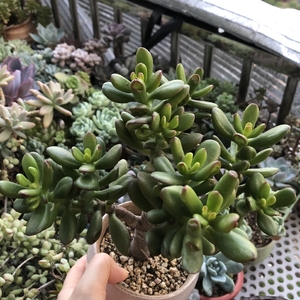
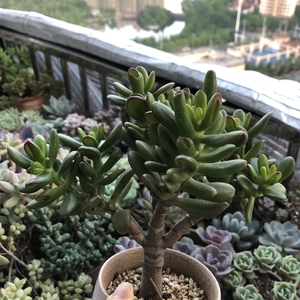


0
0



